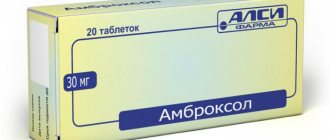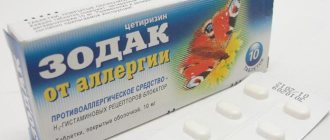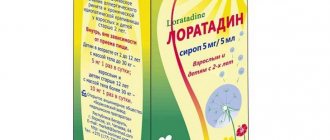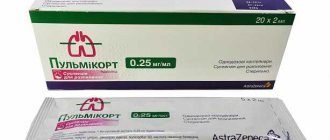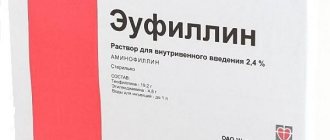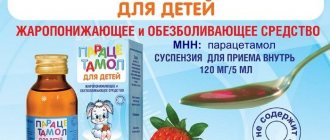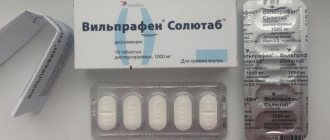The basis of the drug Ambrobene is the active substance ambroxol. In terms of composition, it belongs to the group of benzylamines and is a metabolite of bromhexine. But, unlike bromhexine, this substance does not have a methyl group, but has a hydroxyl group. Ambroxol has secretolytic, secretomotor and expectorant effects. Ambrobene begins its therapeutic effect within half an hour after ingestion. Tablets, solution and syrups continue to act for a period of 6 - 12 hours, depending on the amount of medicine taken. Extended-release capsules have a therapeutic effect for 24 hours.
If Ambrobene is introduced into the body using injections, then it quickly penetrates into the tissues. Subsequently, part of the administered drug is concentrated in the lungs. When taken internally, the medicine enters the body through the gastrointestinal tract.
Contraindications and side effects
Ambrobene does not have many contraindications.
The main contraindication is individual sensitivity to any component of the medicine. It should also not be treated in the first 3 months of pregnancy. It should be used with caution if the motor function of the bronchi is impaired or when too much sputum is produced. It should also be used with caution in the presence of gastrointestinal ulcers, especially the stomach and duodenum in the acute period
Its use during pregnancy and breastfeeding requires, as usual, a careful approach. There is not enough research on the effect of this active substance on the course of pregnancy and the health of the baby. Therefore, before prescribing, a balanced assessment decision is made: benefit to the mother/possible harm to the fetus or baby. It is worth remembering that ambroxol passes into breast milk and is able to cross the placental barrier.
The presence of serious liver and kidney diseases requires the patient to adjust the dose in the direction of decreasing and increasing the intervals between doses. Side effects are not so common when using this drug, but they still occur. A hypersensitivity reaction to the components of the drug may occur (itching, rash, anaphylactic shock, Quincke's edema). Nausea, vomiting, bloating, and diarrhea may occur. In addition, dry mouth and impaired taste perception may occur.
Contraindications
Despite its high medicinal qualities, the drug Ambrobene has contraindications. It is not recommended for use in cases of hypersensitivity to ambroxol or any excipient. It is strictly forbidden for pregnant women to use all types of medicine during the 1st trimester.
Additional restrictions exist for tablets. Do not take for children under six years of age or for those with glucose-galactose malabsorption or lactose intolerance. Extended-release capsules are not recommended for use by children under twelve years of age. The syrup is contraindicated in patients with fructose intolerance.
Ambrobene should be taken with caution when bronchial motor function is impaired and when there is increased sputum production due to immotile cilia syndrome. Oral dosage forms are contraindicated during periods of exacerbation of gastric and duodenal ulcers. Be careful when using Ambrobene during the 2-3 trimester of pregnancy and during the lactation period.
Take special care in case of impaired renal function or severe liver disease. In these cases, reduce the dose of Ambrobene and increase the time intervals between doses of the drug.
Dosage of the drug, method of administration
How should I use Ambrobene? How many drops should be given to adults and children? The instructions say that this solution should be taken orally only after eating food. For proper dosing of the medication, it is advisable to use a measuring cup.
Considering the fact that 1 ml of the solution in question contains 7.5 mg of ambroxol, the drug "Ambrobene" is prescribed in the following dosage:
- children under 2 years old – 1 ml, 2 times a day;
- from 2 to 6 years – 1 ml, 3 times a day;
- from 6 to 12 years – 2 ml, 2-3 times a day;
- from 12 years old and adults - in the first three days, 4 ml, 3 times a day, and in the subsequent days - 4 ml, 2 times a day.
How should I use Ambrobene for inhalation? How many drops are required to achieve the desired effect? To carry out such treatment, you should use any modern equipment (but not steam!).
Before inhalation procedures, the medication must be mixed with a 0.9% NaCl solution (for optimal hydration, the drug is diluted in a 1:1 ratio), and then warmed to the patient’s body temperature.
Therapeutic measures must be carried out in normal breathing mode, so as not to provoke a cough attack.
To avoid nonspecific irritation of the respiratory system, as well as their spasm, people with bronchial asthma should definitely use bronchodilators before inhaling ambroxol.
How many drops (in ml) of Ambrobene are prescribed for inhalation procedures? The dosage in this case is as follows:
- Children under 2 years old – 1 ml, 1-2 times a day.
- From 2 to 6 years – 2 ml, 1-2 times a day.
- From 6 years and adults – 2-3 ml, 1-2 times a day.
Principles of inhalation
Inhalation of the drug should be carried out at home and using a technically serviceable nebulizer. The solution obtained by dilution must be heated to body temperature, poured into an inhaler, put on a breathing mask and perform calm breathing movements.
- You should not inhale deeply
, as this may provoke a coughing attack. - People with bronchial asthma
must use sympathomimetics or short-acting bronchodilators before inhalation to prevent an attack of suffocation. - Inhalation should be carried out until
the drug is completely dissolved in the nebulizer.
How to do inhalation with Ambrobene instructions
The mucolytic composition for inhalation has a minimal number of side effects. Therefore, it can be used at home. But newborn babies should be under the supervision of a pediatrician.
How long does it take to inhale? Nebulization should generally last 5-15 minutes. The duration of inhalation depends on the age of the patient and the amount of medication poured into the device container. Children are advised to inhale the aerosol for no longer than 5 minutes. For adults, the time is extended to 15 minutes.
Before carrying out the manipulation, the liquid must be heated to body temperature so as not to overcool the respiratory organs with the sprayed particles. Your doctor can advise you on how to warm it up.
Adults and children over 6 years old
An aerosol with saline and mucolytic must be administered correctly so as not to cause complications and symptoms of drug overdose. Which method of use is recommended from the age of six?
1
Pour the diluted solution (4 ml) into the container. Maintain one to one proportions. Add 2 ml of medicine and 2 ml of saline solution to the container. 2
The duration of one procedure should not exceed 10 minutes. Young patients are advised to inhale the aerosol for 5 minutes. 3
The mixture is diluted before each manipulation. The procedure is repeated 3 times a day, depending on the doctor’s prescriptions. 4 The course of treatment is usually 5-7 days.
Remember
It is important to adhere to the rules for inhalation through a nebulizer. They are not taken immediately after a meal.
You need to wait an hour and a half after eating and only then begin treatment.
The exact dose of the infused medication is measured using a measuring cup that comes with the bottle.
Dosage for children from 2 to 6 years old
Ambroxol hydrochloride is safely used by patients from the age of two in quiet breathing mode using a nebulizer. This may be a compressor or ultrasonic device, but not a steam one.
After this, the liquid is heated to body temperature, for example by holding the bottle in your hand. The child should not inhale deeply, so as not to cough from the sudden entry of the aerosol into the respiratory tract. The duration of one-time therapy is 3-5 minutes.
Ambrobene inhalation syrup should be used no more than 2 times a day. If children from two to six years old have bronchial asthma, then they are given bronchodilators before the procedure. They prevent spasm of the airways.
How many days are children usually treated with this mucolytic drug? From five to seven days. But, if the child recovers faster, then therapy is canceled a little earlier.
Children under 2 years old and infants
Inhalation with Ambrobene and saline solution can be prescribed even to the youngest patients. But newborns are allowed to perform procedures only under the supervision of a pediatrician. The exact dosage is determined by a specialist; self-medication can lead to dangerous consequences.
What does the aerosol taste like? It has neither smell nor taste, so it is suitable for treating children from birth.
For one procedure, you need to take one milliliter of ambroxol hydrochloride and the same volume of saline solution. Physiatry is repeated twice a day. If after the manipulations the cough intensifies and sputum begins to come out, this is very good.
But, since infants do not yet know how to cough up mucus, inhalation is done 3 hours before bedtime. And the child’s pillow should be high so that mucus does not accumulate in the respiratory organs, but is released normally.
Sometimes newborns are prescribed Berodual and Ambrobene together in order to achieve the fastest possible treatment results. This is especially true with the development of bronchial asthma.
It is also recommended to mix Ambrobene and Fluditec, which is indicated for babies from one month of age. It can be inhaled for a runny nose, ARVI, tracheitis, bronchitis.
After completing a physiatry course, you can perform inhalations with mineral water, for example, Borjomi. It has a softening and moisturizing effect and helps normalize mucus drainage.
To help with treatment:
When to do inhalations with Ambrobene solution and saline solution
First of all, the use of inhalations with Ambrobene is prescribed for difficult removal of sputum from the bronchi. The list of diseases includes the following:
Bronchitis. Prescribed for obstruction of patency due to the formation of very thick sputum. For bronchitis, the solution helps make the cough softer by liquefying and removing large quantities of mucus. This factor occurs due to Ambroxol, which is capable of activating the ciliated epithelium quite strongly.
Obstructive bronchitis. With this form of the disease, difficulty and heavy breathing occurs, especially in children. Ambrobene for inhalation makes breathing easier and even reduces the amount of antibiotics used for treatment.
Bronchial asthma. In this case, inhalations should be carried out immediately after the attack occurs. This will help get rid of accumulated mucus and ease difficult breathing. It should be remembered that before this it is necessary to use bronchodilators.
Cough and pneumonia. Cough is one of the main signs of pneumonia, so if you have pneumonia, Ambrobene inhalation solution will help get rid of this symptom.
Only a doctor prescribes the use of Ambrobene solution for inhalation; he also determines the required number of procedures using a nebulizer and the required dosage.
Composition and release form
The main active ingredient of this medicine is ambroxol, which stimulates serous cells located in the glands of the bronchial mucosa. Under its action, cells in the ciliated epithelium are activated, as a result, the viscosity of sputum decreases. Ultimately, the mucociliary effect improves. Ambroxol has antioxidant properties. When used in conjunction with antibiotics, it increases their concentration in bronchial secretions and sputum.
Ambroxol tablets, the active substance ambroxol hydrochloride is contained in an amount of 30 mg per tablet. In addition to hydrochloride, they contain corn starch, lactose monohydrate, magnesium stearate and silicon dioxide.
Long-acting capsules contain 75 mg of the active substance ambroxol hydrochloride per capsule. There are also excipients present here. These are MCC (RN 102 and RS 581), methacrylic acid, hypromellose, ethyl acrylate copolymer and colloidal anhydrous silicon dioxide, triethyl citrate. The capsule is made of gelatin. The cap contains gelatin, iron dyes - yellow, black and red oxides, titanium dioxide.
The syrup contains the active substance ambroxol hydrochloride 0.3 grams per 100 ml. The excipients include 70 percent liquid sorbitol, raspberry flavor, propylene glycol, saccharin and purified water.
The solution for inhalation and internal administration contains 0.75 grams of ambroxol hydrochloride for every 100 ml. In addition, it contains a number of additional substances. 0.1 grams of potassium sorbate, 0.06 grams of 25 percent hydrochloric acid and 99.19 grams of purified water.
The solution for intravenous administration contains 15 mg of ambroxol hydrochloride for every 2 ml. Additionally, it contains substances such as citric acid monohydrate - 1.8 mg, sodium chloride - 13.6 mg, sodium hydrogen phosphate heptahydrate - 4.7 mg and 1979.9 mg of water for injection.
Compound
The pharmacological properties of the drug are caused by the active and auxiliary substances included in Ambrobene. The composition of the syrup includes the active substance ambroxol hydrochloride, a product of the metabolism of bromhexine hydrochloride.
According to the instructions for use attached to Ambrobene, the syrup contains 15 mg of ambroxol hydrochloride per 5 ml of medication, a 0.1 liter bottle contains 300 mg of the active substance.
Excipients included in 100 ml of Ambrobene syrup:
- sorbitol liquid form 70% (sorbitol, glucite) - 60 g;
- purified water - 49.44 g;
- raspberry flavoring 0.1 g;
- food additive propylene glycol (E-1520) – 5 g.
Excipients help maintain the thickness and richness of Ambrobene and give the syrup a characteristic raspberry flavor.
During pregnancy
At the moment, there are no confirmed clinical studies that would give a definite answer whether ambroxol hydrochloride can be prescribed to pregnant women. In the first and second trimester, only a doctor can decide whether to prescribe a medication or choose another, safer one.
The composition of the mucolytic drug is absorbed through the placental barrier and excreted in breast milk. This must be taken into account when treating pregnant and nursing mothers.
The same condition applies to the lactation period, because the active ingredient is excreted in breast milk. It is impossible to say for sure whether there will be a risk for the baby.
Contraindications and side effects
Inhalation is prohibited for people with the following pathologies:
- Impaired functionality of the bronchial muscles, in which the evacuation of secretions is difficult;
- Serious liver diseases;
- Hypersecretion of mucus.
Very rarely, patients experience side effects. Temporary dry mouth, vomiting, and gastrointestinal pain are possible. If symptoms do not go away, therapy is discontinued.
Overdose in the form of signs of intoxication was not observed. But a large amount of the substance can lower blood pressure and increase salivation. Nausea and vomiting occur. Sometimes allergic reactions occur.
Analogues are cheaper: what can be replaced?
A cheap drug that has a mucolytic effect is Ambroxol. It is an excellent substitute for Ambrobene because it contains the same active ingredient. Also suitable:
- Ambrohexal
- Lazolvan
- Flavamed
- Neo-Bronchol
- Mucosolvan, etc.
Adverse reactions
Exceeding the recommended ratio or non-compliance with treatment conditions may provoke undesirable effects. They appear rarely and go away on their own within 48 hours. If this does not happen, you need to contact a specialist.
Adverse reactions are:
- allergies, namely rashes on the skin, itching, shortness of breath;
- headache;
- constant weakness and apathy;
- anaphylactic manifestations (the most rare);
- discomfort in the stomach;
- nausea, as well as other dyspeptic disorders - constipation or diarrhea, productive vomiting.
There may be high or constant dryness of the mucous membranes of the gastrointestinal tract and oral cavity, rhinorrhea (excessive mucus production), exanthema (skin rashes) and dysuria (difficulty urinating).
Instructions for use
Despite their apparent simplicity, respiratory infections pose a certain danger, and their treatment should be carried out under the guidance and supervision of a physician.
Dosage for children and adults
How to take Ambrobene tablets? The instructions for use do not recommend Ambrobene tablets for children under six years of age. Drug dosage schedule:
- from 6 to 12 years old, children should drink half a tablet 2-3 times a day;
- Adults and children over 12 years of age are prescribed to take the whole tablet three times a day for the first two days of use.
As symptoms improve in children and adult patients, the amount is reduced to one tablet twice daily. Instructions for the use of Ambrobene tablets for adults allow the dose to be increased when treatment does not provide a significant effect. If there is no visible improvement in the first two days, up to 2 tablets twice a day are recommended.
How to use?
Having asked the question of how to take Ambrobene in tablets, let’s turn to the properties of the main ingredient of the drug - ambroxol.
This is a mucolytic agent; drinking plenty of fluids is recommended to liquefy and remove mucus from the lungs. The medicine is not chewed, it is swallowed as a whole tablet. You need to take the tablets after meals.
How many days to use the drug depends on the complexity and course of the disease. The duration of treatment is prescribed by the therapist after analyzing the symptoms.
special instructions
According to the instructions for use, Ambrobene has contraindications:
- Do not take tablets if you are hypersensitive to the main ingredient - ambroxol;
- do not use the medicine if you are diagnosed with an allergy to lactose or difficulties with its digestion and absorption;
- Do not use the drug in the first trimester of pregnancy - up to 12 weeks.
There is not enough information regarding the use of the medicine by pregnant women to make accurate conclusions.
During pregnancy, the instructions for use allow taking the drug only in the second and third trimester. But treatment is prescribed only after carefully weighing the risks to the fetus. The effect of the drug was tested on animals; no violations of embryonic development were observed. Therefore, consultation with a gynecologist is necessary. It may be better to choose a different medicine to relieve your symptoms.
The instructions for use indicate that the active component of Ambrobene, ambroxol, passes into breast milk. Therefore, for nursing mothers, the medicine is prescribed exclusively by a doctor.
It is important to determine the balance between the risks for the child and the benefits for treating the mother.
Consultation with the attending physician is required when Ambrobene is intended to be used in patients with the following pathologies:
- bronchial dysfunction;
- stomach and duodenal ulcers;
- kidney dysfunction;
- liver diseases.
The peculiarities of taking the drug Ambrobene by patients with such diseases, as well as the duration of the course of therapy and dosage are prescribed by the doctor after analyzing information about the patient and conducting the necessary research.
Side effects from the drug are extremely rare. As with any drug treatment, it is necessary to monitor your well-being. Very rarely, but allergic manifestations occur in the form of:
- rash;
- shortness of breath;
- swelling;
- itching.
Anaphylactic shock is extremely rare. Side effects from the gastrointestinal tract are also infrequent. May occur:
- nausea;
- vomit;
- intestinal problems.
The instructions for use of the drug Ambrobene say that consuming up to 25 mg of ambroxol per kilogram of a person’s weight per day will be the most comfortable for the body. Accidental overdose is fraught with increased salivation, vomiting and low blood pressure. In this case, it is necessary to rinse the stomach in the first couple of hours, and also begin treatment for possible accompanying symptoms.
When taking Ambrobene, one must take into account its combined effect with other medications:
- taking medication together with antibiotics increases the concentration of the antibiotic in mucus and bronchial secretions;
- Do not use cough suppressants.
The instructions for using Ambrobene 30 mg tablets state that the shelf life of the medicine is five years.
The final expiration date is indicated on the packaging and on each blister. The manufacturer strictly warns to store the drug at a temperature not exceeding 25 C and not to use the medicine after the expiration date. The package contains 20 tablets, 10 in each blister. On one side there is a mark for convenient dividing the tablet in half.
Interaction with other drugs
When using Ambrobene syrup, you should take other antitussive drugs with caution, as their interaction can cause sputum retention in the bronchi. Before combining such drugs, you should consult your doctor.
We recommend: Inhalation for dry cough with a nebulizer for children
You should also be careful when taking Ambrobene and antibiotics together, for example, Amoxicillin, Erythromycin, Doxycillin and others. Their combination can lead to increased concentrations of antibiotics in sputum.
Directions for use and doses
The drug Ambrobene is used orally, by inhalation or intravenous administration. The duration of treatment is determined individually, depending on the severity of the disease. Taking Ambrobene on your own, without a doctor's prescription, should not last more than 4-5 days. The mucolytic effect of Ambrobene is enhanced by consuming liquid in large quantities.
The tablets are taken orally after meals. They are swallowed without chewing. When taking tablets, you need to use as much liquid as possible.
Children 6-12 years old take half a tablet 2-3 times a day. For children over 12 years of age and adults, the daily dose is 3 tablets in the first 2-3 days of treatment. Then, Ambrobene is taken twice a day, one tablet. If it is necessary to enhance the therapeutic effect, the daily dose for adults can be increased to four tablets.
Extended-release capsules are taken orally in the same way as tablets. The daily dose for children over 12 years of age and adults is one capsule or 75 mg of ambroxol.
The syrup is taken orally after meals. The required dose is determined using the measuring cup included with the drug. The daily children's dose is: up to 2 years – 0.5 cup, 2 times; 2-6 years – 0.5 cup, 3 times; 6-12 years – 1 glass 2-3 times a day.
Adults and children over 12 years of age take Ambrobene syrup as follows: during the first 2-3 days of therapy in the amount of 2 measuring cups three times a day. In case of low effect of therapy, the daily dose for adults is increased to 4 glasses. In the normal course of the disease, the dose of the drug is reduced to two glasses taken twice a day.
Solution for oral administration and inhalation. The solution is taken internally after meals by adding it to tea or juice. The supplied measuring cup is used to determine the dose. Children take medicine daily depending on age: up to 2 years – 1 ml twice; 2-6 years – 1 ml three times; 6-12 years – 2 ml of solution 2-3 times a day. Children over 12 years of age and adults take 4 ml of medication three times a day during the first 2-3 days of treatment. Then, during therapy, the dose is reduced to twice a day. If treatment does not give the desired effect, the daily dose for adults is increased to 8 ml of solution twice a day.
The drug Ambrobene in the form of inhalations is used on any nebulizer, with the exception of steam inhalers. Before inhalation, the medicine must be mixed with sodium chloride (0.9 percent solution) and heated to human body temperature. In order not to provoke coughing shocks when taking a deep breath, normal breathing is used for inhalation.
If the patient has bronchial asthma, it is recommended to take bronchodilator drugs before inhalation. The dose of the solution is determined at the rate of 7.5 mg of ambroxol per 1 ml. Therefore, the pediatric dose is prescribed in the following quantities: up to 2 years – 1 ml 1-2 times a day; 2-6 years – 2 ml 1-2 times a day. For adults and children over 6 years of age, 2-3 ml of the drug is used daily, 1-2 times, depending on the severity of the disease.
The solution for intravenous administration is applied at a slow pace, by stream or drip. The solvent for it is a 0.9 percent sodium chloride solution, a 5 percent glucose solution and other similar products. The daily dose is 30 mg per 1 kg of body weight. This dose is evenly distributed four times.
When used intravenously, the solution is infused for at least 5 minutes. After the acute manifestations of the disease cease, instead of injections, the drug is taken in other dosage forms.
If the normal functions of the kidneys or liver are impaired, then the dose of the medicine is reduced and the time intervals between doses are increased.
General description of Ambrobene
The instructions for use of Ambrobene indicate all forms of release. There are 5 of them. Information about all forms is presented below.
Ambrobene tablets
The product in tablets is sold in plastic blisters of ten pieces. In appearance they are white, round, biconvex pills. There is a mark on one side, there is no engraving.
Ambrobene syrup
Ambrobene's caramel flavor and berry aroma make it pleasant to drink. The syrup is uncolored or slightly yellowish, transparent and viscous. It is sold in dark glass bottles placed in cardboard packaging. It also has a measuring container.
Delayed release capsules
Gelatin extended-release capsule form is a gelatin container containing pellets inside. They are packaged in plastic contour cellular pallets of 10 pieces.
Two-in-one solution for oral administration and inhalation
Inhalations with Ambrobene are carried out using a liquid that can be taken orally. The yellowish (or caramel-colored) transparent suspension is odorless. The container into which the emulsion is poured is the same as that of the syruped form.
Solution for injections and droppers
Injection liquid for injection into a vein is a colorless emulsion, poured into glass ampoules. Plastic trays hold 5 ampoules with a capacity of 2 ml.
The principle of action of the medicine
The use of Ambrobene by adults or children is indicated if the patient needs a mucolytic or expectorant effect.
The active substance of the medicine in question is ambroxol. The latter is a metabolite (active) of bromhexine, the action of which is aimed at stimulating intrauterine or prenatal lung development. Thus, while taking the drug in question, the secretion and synthesis of pulmonary surfactant can increase, and subsequently its decay can be blocked.
What makes Ambrobene most effective? This medicine exhibits secretolytic, secretomotor and expectorant properties. It is able to activate the work of serous cells of the glands located in the bronchial mucosa. Also, taking the drug increases the volume of mucous secretion, stimulating the effect on surfactant in the bronchi and alveoli, causing its release.
It should also be said that intravenous administration or oral administration of Ambrobene restores the disturbed balance of serous and mucous components of sputum. The main substance of the drug activates hydrolyzing enzymes, promotes the release of lysosomes from Clara cells, which are located in the bronchioles and lungs, and also improves the functioning of the cilia of the epithelium (ciliated). Thanks to this effect, not only the liquefaction of sputum occurs, but also the mucociliary transportation of pathological secretions is significantly improved.
pharmachologic effect
The active substance of the drug is ambroxol
. When a microbial agent penetrates the bronchi and lungs, hyperemia, swelling of the tissues of the bronchial tree occurs, with hypersecretion of bronchial contents, and impaired mucociliary clearance.
All this contributes to the accumulation of cellular decay products in the lumen of the bronchi and the formation of mucopurulent exudate. Ambroxol is a mucolytic
, capable of improving the rheological parameters of sputum, reducing the level of viscosity and thereby increasing its discharge from the bronchi.
Increases the activity of the ciliated epithelium
and improving the movement of sputum along the tracheo-bronchial tree. Increases the production of special enzymes that destroy biochemical compounds responsible for the viscosity of sputum at the cellular level.
Forms surfactant
, due to which the mucolytic effect of ambroxol is enhanced. The drug is quickly absorbed in the stomach and enters the general bloodstream. It begins to act after 30 minutes, the maximum concentration in the blood occurs on the 3rd day of use.
The main route of elimination from the body is through the kidneys. Through them, 90% of the drug is excreted, the remaining 10% is metabolized in the liver. The half-life takes 7-12 hours, which significantly increases its total concentration in the blood.
The active substance is able to penetrate into the cerebrospinal fluid and through the cerebrospinal fluid flow through the placenta and into breast milk.
In the fall, during times of stress and vitamin deficiency, a person’s immunity weakens, so it is so important to strengthen it. The drug is completely natural and allows you to recover from colds in a short time
It has expectorant and bactericidal properties. Strengthens the protective functions of the immune system, perfect as a prophylactic. I recommend.
Instructions for use
Even if the medicine was prescribed by a specialist, it is important to study all the nuances specified in the instructions for use. Ambrobene's abstract contains complete data on the features of use, restrictions and prohibitions
Dosage for children and adults
The use of Ambrobene directly depends on the age of the patient. Additionally, each dosage form is consumed in a different dosage. You can only drink one type of product at a time.
Table 2. Ambrobene dosage depending on the release form.
| Type | Quantity |
| Solution | For children under two years of age, 1 ml of the drug twice a day is recommended; from 2 to 6 years the same amount three times a day; over 6 – 2-3 ml once or twice a day. |
| Syrup | Instructions for use of Ambrobene for children under two years of age specify 2.5 ml of the drug twice; from 2 to 6 years the same amount three times; 6-12 years 5 ml three times a day. For adults and children over 12 years of age, the first 72 hours: 10-20 ml 3 times a day, then 10 ml 2 times a day. |
| Pills | Half tablets for children from – to 12 years old per day. For adults and children over 12 – 60-120 mg of the drug. Each Ambrobene 30 mg tablet (instructions for use contain detailed dose information) |
How to drink?
How to drink Ambrobene is also influenced by the form of its release. According to the instructions for use:
- Solution. This dosage form has no special instructions. To determine the exact dose, it is recommended to use a measuring cup.
- Syrup. After consumption, do not take food, liquid or smoke for half an hour.
- Pills. The method of using Ambrobene in tablet form is to chew the product and do not drink it with water. Do not consume food or water for 30 minutes after administration.
Before or after food?
The intake of many medications is related to diet.
However, answering the question about how to drink Ambrobene - before or after meals, we can say that the product is not one of those. It can be consumed regardless of diet. The solution can be added to food and liquids. However, it is not recommended to take other dosage forms with water or eat them for a certain period of time.
How many days should I take it?
The instructions for use do not give a clear answer to this question. How many days to take Ambrobene is determined by the attending physician, based on the patient’s dynamic indicators.
What cough is Ambrobene for?
The pathological secretion (sputum) formed on the epithelium of the respiratory tract is expelled through coughing. The cough may be:
- wet (productive), with discharge of mucous secretions;
- dry (unproductive), without sputum production, which complicates the course of the disease.
A non-productive cough is more difficult to treat; it is necessary to select medications, the use of which will help thin the mucus, remove it from the body, and transform the cough into a productive form.
What cough is Ambrobene syrup for? According to the instructions for use, it is used for any type of cough with sputum that is difficult to clear, primarily for a productive cough with thick secretions. The use of Ambrobene syrup is also effective for dry coughs, as it has the following actions:
- Secretomotor. Stimulates the discharge of mucous secretions.
- Mucolytic (secretolytic). Reduces the viscosity of sputum and promotes its rapid removal from the body.
- Expectorant. Provides removal of bronchial secretions from the respiratory tract.
To normalize the secretion of the lower respiratory tract, Ambrobene syrup is used in conjunction with an increased drinking regimen.
What is better Ambrobene or
What kind of cough Ambrobene is for, dry or wet, how exactly to drink it and in what doses is indicated in the instructions. Studying the annotation allows you to evaluate the advantages and disadvantages of the product over others.
Ambrohexal
The product costs on average two times cheaper, which leads to a logical question: Ambrobene and Ambrohexal - what is the difference? Apart from the price - perhaps only in the list of additional components. The active substance is identical. Ambrobene or Ambrohexal, which is better and more effective - it is better to check with your doctor.
Ambroxol
What is better - Ambroxol or Ambrobene?
In fact, these drugs are very close. They are both made on the basis of ambroxol, but differ in the list of additional substances. Manufacturers differentiate them. According to the instructions for use, Ambroxol is produced by medical factories located in different countries, and Ambrobene is produced in Germany. Polish, Serbian, Romanian, Ukrainian and Russian Ambroxol is cheaper.
Ascoril
This product is made using several active substances at once. It effectively dilutes tracheobronchial secretions and stimulates mucociliary clearance. It is used to treat pneumonia, whooping cough, asthma, etc. This remedy is more powerful, but, according to the instructions for use, it has an impressive list of side effects. Which is better, Ascoril or Ambrobene, depends on the individual indications of the patient.
ACC
This is a synonymous drug that has an identical effect. It is made on the basis of another active substance. It’s hard to say which is better, Ambrobene or ACC. Depends on the patient’s sensitivity to one or another active component.
Bromhexine
Analogue products.
One of the clear advantages of Bromhexine is the price. The drug costs slightly less. Bromhexine is also characterized by a wider range of indications for use. According to the instructions, it causes more side effects. What is better, Bromhexine or Ambrobene, is decided by a specialist.
Lazolvan
A high-quality German product that is distinguished by effectiveness, a minimum number of side effects and a reliable German manufacturer. When evaluating Lazolvan or Ambrobene, which is better and more effective, the majority leans towards Lazolvan. This drug is milder and does not cause bronchospasms, but is almost 3 times more expensive.
Sinekod
Sinekod, although used to treat coughs, is fundamentally different from Ambrobene. First of all, it is an antitussive drug. It is used for laryngitis, tracheitis, bronchitis, etc. It is not used in cases where it is necessary to remove phlegm from the lungs. Sinekod or Ambrobene, which is better? These drugs cannot be compared; they are used to solve different problems.
Fluditek
The mucolytic agent, according to the instructions for use, is recommended for the treatment of diseases affecting the upper respiratory tract in the acute stage with viscous sputum. Also prescribed for diseases of the nasopharynx or in preparation for bronchoscopy. Which is better, Fluditec or Ambrobene, directly depends on the patient’s diagnosis.
Ambrobene: syrup for children
When treating a child’s cough, it is most often recommended to use Ambrobene in the form of syrup , since, due to the fact that it contains saccharin and raspberry flavoring, it tastes very pleasant. According to the instructions, the drug is prescribed for bronchitis, pneumonia and other protracted pathological processes in the lungs, as a means of facilitating sputum discharge, as well as for bronchial asthma.
Ambrobene is recommended for children as an effective and effective remedy for the treatment of dry cough. This is perhaps the most unpleasant and debilitating type of cough, which negatively affects not only the physical, but also the mental state of the child, leading to irritability and fatigue. Ambrobene syrup successfully copes with these symptoms, and the result of the drug’s action occurs very quickly - as a rule, no longer than half an hour.
The duration of medication is selected individually and depends on the stage at which the disease is located. The dosage must be calculated strictly according to the instructions. For ease of dosing, a special measuring cup is included in the kit. It is strongly not recommended to use the drug for longer than four to five days without a doctor’s prescription. During the treatment period, it is advisable to drink plenty of fluids, since drinking fluids greatly contributes to the mucolytic effect of the drug.
Ambrobene indications for use
Each cough medicine usually has a number of indications. They must be taken into account in order for the medicine to give maximum effect. The mucolytic agent "Ambrobene" is recommended for use for pneumonia, acute bronchitis, chronic respiratory diseases, and bronchial asthma. Doctors advise using the medicine as the main therapy, but supplementing it with other means for a more pronounced and faster effect. You can also combine it with traditional medicine.
List of side effects
Side effects are observed in the digestive tract and nervous system. After consuming oral dosage forms, the following appear:
- migraine;
- increased fatigue;
- fever;
- abdominal cramps;
- attacks of nausea;
- problems with bowel movements;
- dry mouth.
Side effects after inhalation:
- taste disturbances;
- dyspepsia;
- diarrhea;
- gagging.
After injections:
- fever;
- pain in the epigastric region;
- fast fatiguability;
- swelling;
- attacks of nausea;
- migraine.
If the therapeutic norm is significantly exceeded, anaphylactic shock may develop.
Migraine
General characteristics of the drug "Ambroxol"
A mucolytic drug that has an expectorant, secretolytic and secretomotor effect. As a result of the process of converting the polymer into a monomer in pathological secretions, the medication helps reduce the viscosity of sputum, and also normalizes the ratio of serous and mucous substances, increases the motor activity of ciliated epithelial tissue, enhances the elimination of harmful organisms and facilitates the elimination of pathological secretions from the respiratory organs. At the same time, Ambroxol has a direct effect on Clark cells, which are located in the bronchioles of the lungs.
The drug helps activate surfactants that prevent the alveoli from collapsing during exhalation.
When tablets are taken orally, the active substance is instantly and completely absorbed from the gastrointestinal tract into the tissues, accumulating in the greatest quantities in the lungs. The maximum concentration is reached after approximately three hours. The cost of the medicine is 70 rubles.
special instructions
It should not be combined with antitussive drugs that impede the removal of sputum.
Severe skin reactions, such as Stevens-Johnson syndrome and Lyell's syndrome, have been observed extremely rarely when using Ambrobene. If there is a change in the skin or mucous membranes, you must immediately consult a doctor and stop taking the drug. The effect on the ability to drive vehicles and control machines and mechanisms is still unknown.
Peculiarities
Before you start using Ambrobene tablets, you should carefully read the instructions for use. In this case, it is necessary to pay attention to certain features:
- The use of the medicine in the first three months of pregnancy is contraindicated, since there is no reliable information about the absence of negative effects on the fetus. In the second and third trimester, taking the medicine is possible only after the permission of the doctor, who carefully weighs all the risks. The same applies to taking pills during lactation.
- According to the instructions for Ambrobene tablets, for children under two years of age the drug is prescribed only by a medical specialist on an individual basis.
- Ambrobene is not recommended to be taken simultaneously with medications that suppress cough, as this can lead to stagnation of pathological secretions in the respiratory tract.
- If a negative process occurs in the liver or kidneys, the medication is prescribed with extreme caution and with constant monitoring of the functioning of the organs.
- On average, therapy using Ambrobene tablets for children (according to the instructions for use) lasts four to five days. When prolonging treatment, it is important to consult a medical specialist.
- The combined use of Ambrobene and antibacterial agents increases the content of the latter in pathological secretions, thereby increasing the rate of elimination of infection in the respiratory system.
- The medicine does not affect the speed of patient reactions, so its use is allowed for people whose work requires increased concentration.
"Ambrobene" is an over-the-counter drug that is sold freely in pharmacies. If you have any questions, it is advisable to consult a doctor.
Overdose
Symptoms: There were no signs of intoxication with an overdose of ambroxol. There are reports of nervous agitation and diarrhea.
Ambroxol is well tolerated when taken orally at a dose of up to 25 mg/kg/day.
In case of severe overdose, increased salivation, nausea, vomiting, and decreased blood pressure are possible.
Treatment: intensive therapy methods, such as inducing vomiting, gastric lavage, should be used only in cases of severe overdose, in the first 1–2 hours after taking the drug. Symptomatic treatment is indicated.
Analogues of the drug
Instead of Ambrobene, the following medications can be used:
- Lazolvan is an original drug; it contains ambroxol as a therapeutic substance. Available in film-coated tablets, lozenges, syrup, solution for inhalation and oral administration. In a suitable dosage form, the medicine can be given from birth. Lazolvan should not be taken in the first trimester and during breastfeeding.
- Fluimucil antibiotic IT is a substitute for the drug Ambrobene in the clinical and pharmacological group. Its active component is thiamphenicol glycinate acetylcysteinate, which has an antimicrobial and mucolytic effect. The drug is active against gram-positive and gram-negative microorganisms. The drug is produced in a lyophilisate from which a solution for inhalation and injection is prepared. The medication should not be taken during lactation. During pregnancy and children under 2 years of age, it should be prescribed with caution.
- ACC is a substitute for the drug Ambrobene in the therapeutic group. As a mucolytic agent, the drug can be used in children from birth. ACC is contraindicated for pregnant and lactating women.
- Codelac Broncho is a combination medicine containing ambroxol, chlorphenamine, phenylephrine, guaifenesin. It is sold in the form of syrup. It is contraindicated to be prescribed to patients under 6 years of age, pregnant women and breastfeeding patients.
Analogues and prices
Among foreign and Russian analogues of Ambrobene there are:
Ambroxol. Manufacturer: Hemofarm 83 rub. Flavamed. Manufacturer: Berlin-Chemie AG (Germany). Price in pharmacies from 190 rubles. Lazolvan. Manufacturer: Boehringer Ingelheim (Austria). Price in pharmacies from 281 rub. Ambrohexal. Manufacturer: Sandoz (Switzerland). Price in pharmacies from 99 rubles. Halixol. Manufacturer: Egis (Hungary). Price in pharmacies from 121 rubles.
Analogs
Many drugs are produced with almost the same composition (ambroxol hydrochloride is one of the most popular mucolytics). However, the use of different dosages and the presence of additional components may have additional effects. The list of similar drugs is compiled taking into account the presence of the active ingredient - ambraxol, but is not a recommendation for independently replacing a drug prescribed by a specialist.
Analogues of "Ambrobene":
- Abrol.
Abrol syrup
- Ambrohexal. (and for those who want to read the instructions for using Ambrohexal for inhalation for children, you should follow the link and read the contents of this article.)
Ambrohexal syrup
- Ambroxol.
(How to use Ambroxol for a wet cough is described in great detail in this article.) Ambroxol syrup
And also: Ambroxol hydrochloride, Ambrosan, Ambrotard, Asibrox.Ac - fs, Acestad, Acetal, Acetylstein, Acetine, Acetsex, Acysteine, Acs, Bromhexine syrup, Bronchoval, Bronchohex, Bronchoimucil, Coldactbroncho, Cofacin, Lazolvan (they also do inhalations with Lazolvan ), Medox, Mucolvan, Mukolic, Muconex, Mucitus, Mukosol, Neobronchol, Rinatiol, Pectolvan, Solvin, Salbroxol, Flavamed, Fluimucil, Fluifort, Fluditek, Helpex.
"Ambrobene" is an inexpensive and very effective drug. It is used for non-productive dry cough, promoting the production of sputum and its elimination. The drug has many analogues, but replacing it independently during treatment is unacceptable. Features of administration, indications and possible side effects are discussed in the information in this article.
What are the symptoms and treatment of allergic cough in adults and is it possible to cope with the problem on your own?
This article will help you understand what to do when a 3-year-old child has a runny nose and cough.
This information will help you understand why a strong cough occurs in the morning and how you can cope with it on your own.
Side effects
The cough medicine Ambrobene has some side effects after taking it. They happen rarely, usually when the medicine is used incorrectly.
- risk of developing chronic runny nose;
- drying out of the respiratory canals;
- stomach pain;
- stool disorder;
- urticarial rash.
In isolated cases, anaphylactic shock is observed. When using the drug intravenously, there is a risk of headache, shortness of breath, and high blood pressure.
Reviews
Patient reviews of Ambrobene solution are mostly positive: the cough medicine acts quickly and has no side effects on the body. In addition, the medicine is affordable and available without a prescription.
Judging by the reviews, Ambrobene solution in the form of inhalations for children copes not only with coughs in diseases such as acute respiratory infections and acute respiratory viral infections, but also helps with the resumption of symptoms of chronic bronchitis. Ambrobene solution for children is positioned as a fast-acting expectorant.
The instructions for use of the drug indicate exactly how to take Ambrobene solution for children, everything is accessible and simple, parents do not have any unnecessary questions.
Operating principle
Ambrobene contains a derivative of bromhexine. The main component is quickly absorbed and distributed by the blood throughout the soft tissues. With regular use, Ambrobene stimulates the normal functioning of the lungs and bronchi.
The annotation describes the following therapeutic properties of the drug. These include:
- emollient;
- antispasmodic;
- secretomotor;
- secretolytic.
The medication breaks down and reduces the viscosity of exudate from the bronchial ducts. It can be used for any type of cough caused by respiratory diseases.
Russian scientists conducted clinical trials of Ambrobene. It was given to 140 children for 7 days. In 54%, a general improvement appeared after 3 days, in 24% a decrease in cough attacks was detected after 2 days. In 20% of children with a wet cough, sputum elimination accelerated after 2 days. The drug did not bring relief to 2% of children.
What are the contraindications?
According to the instructions, Ambrobene has a number of relative and absolute contraindications for use. The following are absolute contraindications:
- hypolactasia;
- lactase deficiency;
- glucose intolerance;
- fructose intolerance;
- childhood.
Relative restrictions:
- dyskinesia;
- late stages of pregnancy;
- breast-feeding.
Careful administration and adjustment of the dosage regimen is required for patients with diseases of the digestive system and liver failure.
Late pregnancy
Analogues of "Ambrobene"
The medication has certain substitute drugs, which are no worse in terms of performance. Often, when choosing, the main role is played by the difference in price. If the drug you need is not available, you may be offered an analogue. For example:
- "Ambrosan".
- "Lazolvan."
- "Bronchoxol".
- "Medox."
- "Flavamed"
- "Ambroxol".
- "Ambrohexal".
- "ACC."
- "Bronchorus".
- "Ambrolor".
- "Medox."
- "Lazongin."
- "Mukobron."
- "Remebrox".
